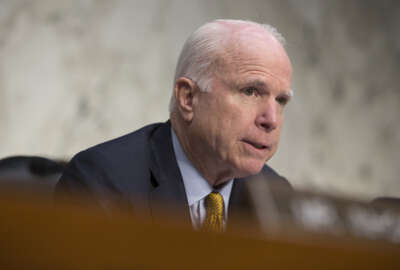
On DoD: time to end ‘abuse’ of Pentagon’s wartime fund
A new report from a Washington-based think tank points to an ever-widening disconnect between the size of the Defense Department’s Overseas Contingency Operations...
A new report from a Washington-based think tank points to an ever-widening disconnect between the size of the Defense Department’s Overseas Contingency Operations (OCO) fund and the troop levels it was originally meant to pay for, citing that fact as one reason to eliminate the separate OCO budget once and for all.
In 2008, what was then called the Global War on Terror fund during the final years of the Bush Administration (renamed OCO in the Obama years) stood at $187 billion, with virtually all of the money going to support deployments to the wars in Iraq and Afghanistan, where about 187,000 military members were serving. In the 2017 budget, $59 billion is still allocated for OCO, but only 10,000 troops are expected to be deployed in what are now called Operation Freedom’s Sentinel and Operation Inherent Resolve.
That means the OCO budget is now being spent at a rate of $5.9 million per troop, per year, compared to $1 million per service member when the separate fund was first conceived, said Laicie Heeley, a fellow at the Stimson Center and a coauthor of the report.
“It’s become a safety valve for a lot of things that belong in the DoD base budget, and the biggest reason is the Budget Control Act,” Heeley said in an interview for a forthcoming edition of Federal News Radio’s On DoD. “Once the budget caps were in place, Congress and the Pentagon were looking for ways to get around them. OCO was ripe for abuse from the beginning because it exists outside the base budget, but the caps almost forced folks to look for a loophole, and that’s exactly what they’ve done. It doesn’t make sense to have a permanent emergency account as part of your budget every year.”
Indeed, these days, it would be difficult to argue that the OCO account is about unexpected wartime emergencies. For the past two years, the Pentagon has submitted a precise OCO request on the same day it proposed the rest of its annual budget — eight months before any of the funds could possibly be spent. And the 2017 budget explicitly acknowledged that at least $5.2 billion of those OCO funds would be used for ongoing military needs.
That’s an artifact of the 2015 Balanced Budget Act in which lawmakers and the White House agreed to put off sequestration for two more years. The budget gymnastics in that agreement included raising the original Defense budget caps while shifting some of the military’s basic budget requirements into OCO.
The report also highlights several categories of spending in the 2017 budget that the authors argue have no reasonable connection to OCO’s original purpose, including $3.4 billion for the European Reassurance Initiative, $3.4 billion to pay for the buildup of Afghanistan’s security forces and $9.4 billion for equipment maintenance and replacement.
The latter function, referred to as “reset” in military budgeting, is justifiable as long as it has some connection to equipment that’s been destroyed or degraded during actual warfighting, Heeley said. But a good deal of the maintenance needs that have been redirected into OCO seem to have to do with equipment that’s been worn down during the military’s normal course of business, including stateside training.
“There’s not, at this point, a huge emergency need for reset at that scale,” she said. “There’s obviously a continuing need to replace things as we go along within the base budget, but when we looked deeper into the funding, a lot of this reset has already taken place during the course of the wars, and you can find some instances where additional depot maintenance and things that the Pentagon has actually had in their plans for a long time have been completed earlier than planned because Congress has provided a fairly liberal amount of money in the budget to do that.”
The Stimson authors argue it’s time to eliminate OCO altogether and return to a system in which DoD must rely only on its base budget for year-to-year expenses. Under that system, the White House would ask for emergency war funding from Congress in cases where the Pentagon must cover new, unexpected costs right away.
Asked if it matters whether DoD’s annual funding is appropriated in two buckets instead of one, Heeley said the OCO process has distorted Defense budgeting in several ways.
“The biggest problem is that OCO, by its very nature, is appropriated as a short-term process,” she said. “You’re not able to use it for the long-term procurement projects the military needs. You might also like to shift some of that money to long-term research and development needs like the Navy’s ballistic submarine replacement, but you can’t. Ultimately what happens is that the Pentagon can’t plan in the way that it would if it had that budget as one full chunk. OCO is one-year funding, and there’s no guarantee in this political atmosphere that any Congress or next administration will keep it going. It’s a very dangerous bet to make.”
In its 2016 budget, the Obama administration signaled an interest in eliminating the OCO accounts and folding all of DoD’s funding into the base budget.
That idea has gone nowhere, and Congress is pointed in an almost opposite direction. The House version of the 2017 Defense bill would add another $18 billion to Defense spending in order to stop an ongoing drawdown of the Army and Marine Corps and to fund a military pay raise of 2.1 percent instead of 1.8 percent.
The $18 billion would be redirected from the funds the Pentagon proposed for its 2017 OCO account, leaving the next Congress and president to replenish the OCO fund with an equivalent amount of new spending if they wished to continue the Pentagon’s current spending trajectory beyond next April.
For the Senate version of the bill, Sen. John McCain (R-Ariz.), the chairman of the Armed Services Committee, proposed a similar approach, but the amendment failed to gain the 60 votes needed to overcome a filibuster by Democrats who argued that non-Defense agencies should also benefit from a workaround to the budget caps and receive a similar plus-up.
The Senate version of the NDAA passed on Tuesday by a vote of 85-13. Its differences with the House version — and there are many — will have to be worked out in an eventual conference committee, but the White House has already issued separate veto threats addressing both versions of the bill over numerous policy issues, including the Senate’s proposal to reorganize the sprawling Office of the Secretary of Defense and the $18 billion in redirected OCO spending the House approved in its version.
Copyright © 2024 Federal News Network. All rights reserved. This website is not intended for users located within the European Economic Area.
Jared Serbu is deputy editor of Federal News Network and reports on the Defense Department’s contracting, legislative, workforce and IT issues.
Follow @jserbuWFED





